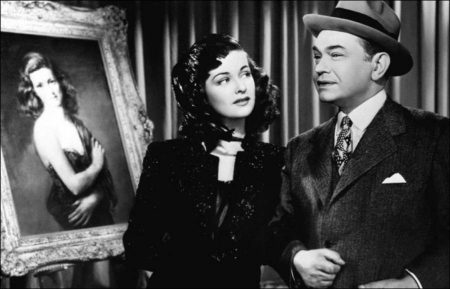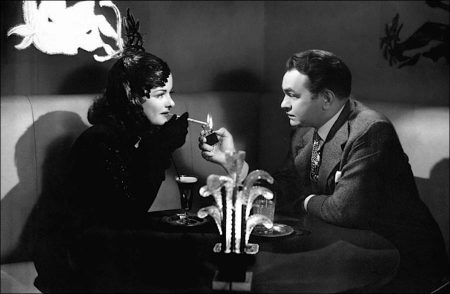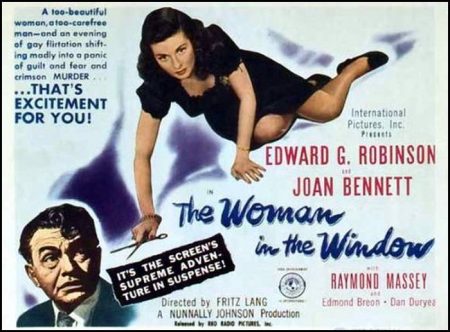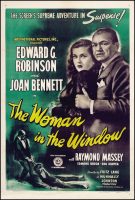Taglines: It was the look in her eyes that made him think of murder.
The Woman in the Window movie storyline. When the family of Gotham College Professor Richard Wanley travels, he meets with his close friends Dr. Michael Barkstane and District Attorney Frank Lalor in a club for talking. Wanley is fascinated with the portrait of a young woman in the next door window, and they discuss about affairs and middle-age crisis while drinking. When Wanley leaves the club, he walks to the window to admire the picture once more and he meets Alice Reed, who was the model of the painting. She invites him for a drink and they end the night in her apartment for seeing sketches of Alice made by the same artist.
While drinking champagne, her temperable lover arrives and misunderstands the presence of Richard, hitting and suffocating him. In self-defense, Richard stabs the man with a pair of scissors on the back and kills him. They decide to get rid off the body, dumping the body in the woods and destroying the evidences, but when they are blackmailed by the scum Heidt, Professor Wanley tells Alice that there are only three ways to deal with a blackmailer, all of them with a high price.
The Woman in the Window is a 1944 American film noir directed by Fritz Lang and starring Edward G. Robinson, Joan Bennett, Raymond Massey, and Dan Duryea. It tells the story of a psychology professor (Edward G. Robinson) who meets and becomes enamored with a young femme fatale (Joan Bennett). The term “film noir” originated as a genre description, in part, because of The Woman in the Window.
Based on J. H. Wallis’ novel Once Off Guard, the story features two surprise twists at the end. Scriptwriter Nunnally Johnson, having written among many others the script to the successful The Grapes of Wrath (1940), was invited by International Pictures to a picture deal, and The Woman in the Window was chosen as its premiere project. Director Fritz Lang substituted the film’s dream ending in place of the originally scripted suicide ending, to conform with the moralistic Production Code of the time.
About the Story
After college professor Richard Wanley sends his wife and two children off on vacation, he goes to his club to meet friends. Next door, Wanley sees a striking oil portrait of Alice Reed in a storefront window. He and his friends talk about the beautiful painting and its subject. Wanley stays at the club and reads Song of Songs. When he leaves, Wanley stops at the portrait and meets Reed, who is standing near the painting watching people gaze at it. Reed convinces Wanley to join her for drinks.
Later, they go to Reed’s home, but an unexpected visit from her rich clandestine lover Claude Mazard, known to Reed initially only as ‘Frank Howard’, leads to a fight in which Wanley kills Mazard. Wanley and Reed conspire to cover up the murder, and Wanley disposes of Mazard’s body in the country. However, Wanley leaves many clues, and there are a number of witnesses.
One of Wanley’s friends from the club, district attorney Frank Lalor, has knowledge of the investigation, and Wanley is invited back to the crime scene, as Lalor’s friend, but not as a suspect. There are several comic dialogues in which Wanley appears to know more about the murder than he should. As the police gather more evidence, Reed is blackmailed by Heidt, a crooked ex-cop who was Mazard’s bodyguard. Reed attempts to poison Heidt with a prescription overdose when he returns the next day, but Heidt is suspicious and takes the money without drinking the drugs. Reed tells Wanley, who overdoses on the remaining prescription medicine.
The Woman in the Window (1944)
Directed by: Fritz Lang
Starring: Edward G. Robinson, Joan Bennett, Raymond Massey, Edmund Breon, Dan Duryea, Thomas E. Jackson, Dorothy Peterson, Arthur Loft, Iris Adrian, Brandon Beach, Frank Dawson
Screenplay by: Nunnally Johnson
Cinematography by: Milton R. Krasner
Film Editing by: Gene Fowler Jr., Marjorie Fowler
Set Decoration by: Julia Heron
Art Direction by: Duncan Cramer
Music by: Arthur Lange
MPAA Rating: None.
Distributed by: Metro-Goldwyn-Mayer
Release Date: November 3, 1944 (United States)
Visits: 106



